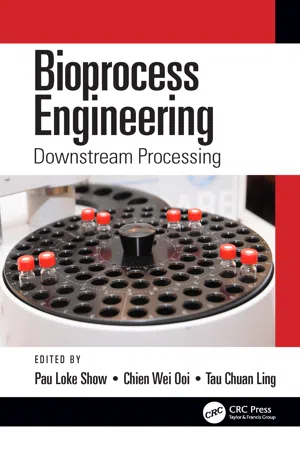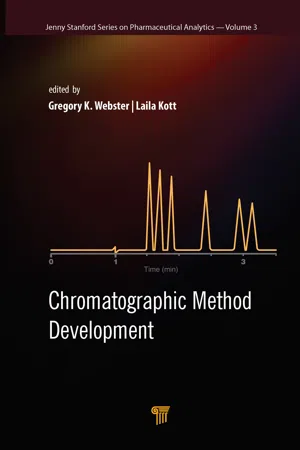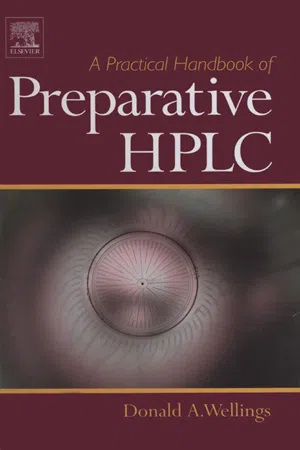Column Chromatography
Column chromatography is a laboratory technique used to separate and purify individual components from a mixture. It involves passing a mixture through a column filled with a stationary phase, which interacts differently with each component, causing them to separate as they flow through the column. This technique is widely used in chemistry for isolating and purifying organic compounds.
7 Key excerpts on "Column Chromatography"
- eBook - ePub
Understanding Bioanalytical Chemistry
Principles and Applications
- Victor A. Gault, Neville H. McClenaghan(Authors)
- 2013(Publication Date)
- Wiley(Publisher)
...Subsequent sections provide more information on the different modes of chromatography and their application. The International Union of Pure and Applied Chemistry (IUPAC) define chromatography as a physical method of separation in which the components to be separated are distributed between two distinct phases. The first of these phases is called the stationary phase and the other is called the mobile phase. Basically, in chromatography, a sample containing a mixture of biomolecules is placed onto a stationary phase (which may be either solid or liquid). A mobile phase (which may be either liquid or gas) is then passed through or over the stationary phase, which causes components in the sample to move along the stationary phase. The diverse physical and chemical properties of individual biomolecules within the sample allow components to separate out because they migrate along the stationary phase at different rates. This migration or separation process is referred to as elution, a term you will come across when considering other bioanalytical techniques. There are two major classifications of chromatography according to whether the separation takes place on a planar surface (i.e. flat sheet, e.g. paper or thin-layer chromatography) or in a column (e.g. ion-exchange chromatography). In addition, these can be further sub-divided into liquid chromatography (LC) and gas chromatography (see Table 7.1), and the following sections focus on the most popular of the LC techniques. Table 7.1 Basic overview of fundamental chromatography techniques 7.2 Principles, types and modes of chromatography Separation of biomolecules by chromatography relies on different features of the molecule and chromatography system (i.e. stationary and mobile phases)...
- eBook - ePub
Bioprocess Engineering
Downstream Processing
- Pau Loke Show, Chien Wei Ooi, Tau Chuan Ling, Pau Loke Show, Chien Wei Ooi, Tau Chuan Ling(Authors)
- 2019(Publication Date)
- CRC Press(Publisher)
...The system comprises a stationary phase (solid) and a mobile phase (liquid or gas). During the twentieth century, pigments present in plants were adsorbed using a solid stationary phase of calcium carbonate and a liquid mobile phase of hydrocarbon. The different solutes carried by the solvent traveled different distances through the solid. Each solute is unique in achieving equilibrium between adsorption onto the solid surface and solubility in the liquid solvent (Heftmann, 1983). The components are separated into different bands based on the adsorbing power; that is, the components that are best adsorbed and are less soluble move slowly. Liquid chromatography containing a column packed with alumina or silica-gel is an example of adsorption chromatography (Figure 6.4). 6.2.1.3 Partition In partition chromatography, a thin layer (or film) of nonvolatile liquid on the surface of an inert solid acts as the stationary phase. The mixture is distinguished using gas or liquid as the mobile phase (Martin, 1950). The solutes in the sample distribute between the mobile and the stationary phases. The component having stronger solubility in the mobile phase reaches the end of the chromatography column faster than the weaker soluble one. Paper chromatography is the best example of partition chromatography (Figure 6.5). 6.2.1.4 Ion Exchange Ion exchange chromatography is more or less similar to partition chromatography. A resin-coated solid acts as the stationary phase (Gerberding and Byers, 1998). The resin is covalently bonded to different ions such as cations or anions, and it is paired electrostatically to ions of the opposite charge. The electrostatically and loosely bound ions are eluted along with the mobile phase first as other ions are strongly bonded...
- eBook - ePub
- Gregory K. Webster, Laila Kott, Gregory K. Webster, Laila Kott(Authors)
- 2019(Publication Date)
- Jenny Stanford Publishing(Publisher)
...Techniques that are employed during stationary phase immobilization/deposition greatly influence the separation efficiency of the GC column. As a result, a fundamental understanding of stationary phase properties, column evaluation, and principles involved in column fabrication methods is useful in GC analysis. This chapter provides an overview on the properties, applications, and procedures used in the fabrication of GC columns that are essential in aiding GC method development. Chromatographic Method Development Edited by Gregory K. Webster and Laila Kott Copyright © 2020 Jenny Stanford Publishing Pte. Ltd. ISBN 978-981-4800-53-2 (Hardcover), 978-0-429-20172-1 (eBook) www.jennystanford.com 11.1 Introduction Gas chromatography (GC) is a separation technique that has been widely used for the analysis of volatile and semi-volatile chemical constituents. GC has become a workhorse separation method in a variety of applications, including petroleum analysis [ 1 ], food sample testing [ 2 ], environmental sample screening [ 3 ], and drug analysis [ 4 ]. The remarkable work on GC in the 1940s by A. J. P. Martin and R. L. M. Synge is considered a milestone in the evolution of modern GC techniques. Advances in column technology have played a significant role in transforming the face of GC. Before optimizing any GC analysis, the selection of an appropriate column type as well as stationary phase is an important prerequisite. GC columns are broadly divided into two classes, namely, packed columns and open tubular columns. In packed columns, a solid material (possessing high surface area) or a liquid coated on the solid support typically functions as the stationary phase. High sample capacity, low phase ratio (ratio of the volume of gas to liquid phase), and a plethora of stationary phase materials that are compatible with column fabrication procedures are characteristics of the classical packed columns...
- eBook - ePub
Physical Biochemistry
Principles and Applications
- David Sheehan(Author)
- 2013(Publication Date)
- Wiley(Publisher)
...As a result, each will interact slightly differently with the stationary phase and, because of different partitioning between phases, will migrate through the column at different rates. Since K will be directly affected by the precise experimental conditions (e.g. temperature, solvent polarity) the chromatographer may vary these to optimize separation. In Column Chromatography, we therefore exploit what are often tiny differences in the partitioning behaviour of sample molecules to achieve their efficient separation. Figure 2.1. Partitioning of biomolecules in a two-phase system. Two components are represented by circles and squares, respectively. The two phases could be an aqueous buffer and a solid stationary phase. The two samples have very different partition coefficients in this experimental system. 2.1.2 Phase Systems Used in Biochemistry In chromatographic systems used in biochemistry the stationary phase is made up of solid particles or of solid particles coated with liquid. In the former case, chemical groups are often covalently attached to the particles and this is called bonded phase liquid chromatography. In the latter case, a liquid phase may coat the particle and be attached by noncovalent, physical attraction. This type of system is called liquid–liquid phase chromatography. A good example of liquid–liquid phase chromatography is silica coated with a nonpolar hydrocarbon (e.g. C-18 reverse phase chromatography; Section 2.4.3). Commonly, the particles are composed of hydrated polymers such as cellulose or agarose. Such particles may be immobilized in a column (Section 2.3.1) and washed with mobile phase. They offer good flow characteristics and possess sufficient mechanical strength and chemical inertness for the chromatography of biomolecules. Because biomolecules have evolved to function in an aqueous environment, it is usually necessary to use aqueous buffers as the mobile phase if we require the molecule to retain its native structure (e.g...
- eBook - ePub
Biopharmaceutical Manufacturing
Principles, Processes, and Practices
- Gary Gilleskie, Charles Rutter, Becky McCuen(Authors)
- 2021(Publication Date)
- De Gruyter(Publisher)
...Chromatography systems can readily and effectively be cleaned and sanitized, ensuring that both batch-to-batch product contamination and microbiological contamination are minimized. To begin the discussion on how chromatography works, consider Figure 8.1(a). A solution containing three colored solutes (fictitious blue, green, and red solutes) is introduced (i.e., loaded) to a cylindrical column that is packed with spherical particles. In chromatography, these particles are referred to as resins or beads, and the resulting column is a packed bed or packed column. The packed column contains a support on each end that keeps the resin in place but allows liquid to flow through. (Note that in addition to resin beads, the column always contains liquid in the space between the beads.) Once packed into a column, the beads do not move and therefore are referred to as the stationary phase. The solution containing the blue, green, and red solutes is loaded under conditions in which each solute has an affinity for the resin and therefore binds to it. After the feed solution is loaded to the column, a change to the liquid flowing through the packed column is made. Any liquid that flows through the packed column is referred to as mobile phase, and the mobile phase used at this step of the procedure is chosen to weaken the interaction between the solutes and the resin so that the column flow can push the solutes downward through the column. The greater the affinity of a solute for the stationary phase, the longer the time it spends bound to the stationary phase and the slower its movement through the bed. Each solute has a different affinity for the resin and therefore moves through the column at a different speed, which leads to separation. In the example shown in Figure 8.1(a), the blue solute has the greatest affinity for the resin and the red solute the least...
- eBook - ePub
Basic Bioscience Laboratory Techniques
A Pocket Guide
- Philip L.R. Bonner, Alan J. Hargreaves(Authors)
- 2011(Publication Date)
- Wiley(Publisher)
...The stationary phase is a micro granular solid that sample components can adsorb to, thus establishing equilibrium with the liquid mobile phase that passes over the stationary phase. The most commonly used solids in this form of chromatography are silica gel (SiO 2), alumina (Al 2 O 3) and cellulose. Polar groups on the surface of these solids form weak interactions (H-bonds and dipole interactions) with samples dissolved in an organic liquid. Good solids for adsorption chromatography should be insoluble in the mobile phase, inert to reaction with the sample and have a small particle size to increase the available surface area. Thin layer chromatography is a sensitive, fast, simple and relatively inexpensive analytical technique. Several samples can be run on the same plate with standards to help in the identification of unknown compounds. It is usually conducted in a planar format with the micro granular solids (adsorbent) bonded to a flat plastic or glass plate. This technique can also be scaled up into a column format to separate larger amounts of sample. Worked Example 7.3: Thin layer chromatography (TLC) of amino acids In a planar format, TLC involves spotting the sample onto the adsorbent near one end of the TLC plate. The plate is placed into a tank containing a small volume of solvent. The tank is covered and the solvent moves through the stationary adsorbent by capillary action (see Figure 7.6). With a pencil lightly score a sample application line (origin) 1 cm from the bottom of the cellulose TLC plate and mark application points on this line. Using a capillary applicator spot 10 ml of the amino acid sample onto an origin point. The best results are achieved by taking time to apply a small concentrated spot rather than a large dilute spot. Hold the applicator in one hand and a hot air blower (hair dryer) in the other, then dot and dry, dot and dry until all the sample has been applied. Place the plate in the TLC chamber...
- eBook - ePub
- Donald A Wellings(Author)
- 2011(Publication Date)
- Elsevier Science(Publisher)
...However, stationary phases from different manufacturers will behave differently, so it is important to reiterate the need to screen seemingly identical materials to get the optimum separation required. 3.1 Normal Phase Chromatography The IUPAC Compendium of Chemical Technology defines ‘Normal Phase’ as ‘an elution procedure in which the stationary phase is more polar than the mobile phase’. In practice, the most widely used stationary phases for preparative HPLC are based on silica and the polarity of the underlying silyl ether and silanol provides the required hydrophilic surface. Amino and cyano bonded silica are also commonly used in normal phase mode though the latter also has some reversed phase properties. The predominant mechanism of interaction is hydrogen bonding. However, the silanol is mildly acidic so the silica surface will also have mild cation exchange properties. Normal phase chromatography is commonly used to purify small organic molecules so the technique is regularly employed in the pharmaceutical and agrochemical industries. The progression from flash chromatography to preparative HPLC has been easy to comprehend for traditional organic chemists and this has probably driven the adoption of the technique for many pilot and plant scale separations. A concomitant transition from irregular particles to mechanically robust spherical stationary phase particles has also been fuelled by the increased demand...






